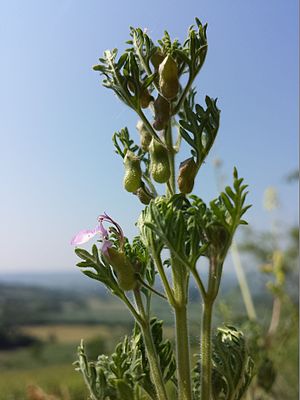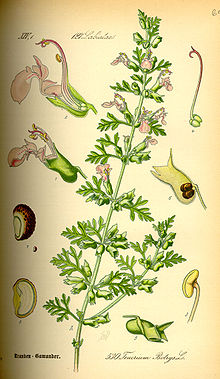Grape germander
| Grape germander | ||||||||||||
|---|---|---|---|---|---|---|---|---|---|---|---|---|

Grape germander ( Teucrium botrys ) |
||||||||||||
| Systematics | ||||||||||||
|
||||||||||||
| Scientific name | ||||||||||||
| Teucrium botrys | ||||||||||||
| L. |
The grape germander ( Teucrium botrys ), also called field germander , is a member of the mint family (Lamiaceae).
description
The annual , rarely also biennial, herbaceous plant reaches a height of 10 to 30 cm. It has an unpleasant odor. The stem is ascending, with glandular, shaggy hairs and is usually provided with arching branches at the bottom. The leaves are long-stalked, 1.5 to 2.5 cm long, the lower ones simple, the upper ones usually double pinnate with lanceolate-linear lobes.
The flowers are 2 to 4 (up to 6) in the axils of the leaves, are about 12 mm long and have 3 to 7 mm long stems. The crown is cloudy pink, very rarely white. The stamens and stylus protrude far and are bent down. The calyx is somewhat inflated, has a large, backward-facing sac and is covered with dense, downy glandular hair.
The nuts are almost spherical, 1.5 to 2 mm long, pitted and rough and have an attachment surface surrounded by a deep furrow.
It blooms from July to October.
The number of chromosomes is 2n = 10, less often 32.
ecology
The flowers show the peculiarity that the flower stalks often turn to the right, so that the lower lip comes to lie to the left or even upwards. This weakly indicated, so-called resupination , occurs regularly in some Mediterranean species.
Distribution and location requirements
The grape germander grows in fields, vineyards, piles of harvest stones, gravel pits, quarries, on scree slopes, on railway embankments and at ruderal sites. It occurs particularly on calcareous, humus and fine earth poor soils, occasionally it can also be found on rock poor in lime. In Central Europe it is a character species of the Teucrio-Melicetum from the association Seslerio-Festucion pallentis.

Teucrium botrys occurs from the western Mediterranean area with Algeria and Morocco to Central and Eastern Europe. It penetrates east to Poland, Ukraine and the northern Balkans. It is a sub-Mediterranean-subatlantic floral element. In Austria and Switzerland one finds it generally scattered. In some areas it is also endangered.
The grape germander occurs in Germany in the southern limestone regions scattered to widespread (including the Upper Rhine and Neckar regions, Palatinate). In addition, it is seldom to be found or only abducted.
literature
- Gustav Hegi : Illustrated flora of Central Europe. Paul Parey Publishing House, Berlin and Hamburg 1975, ISBN 3-489-78021-3
- Christian August Friedrich Garcke : Illustrated flora. Paul Parey Verlag 1972, ISBN 3-489-68034-0
- Wolfgang Adler, Karl Oswald, Raimund Fischer: Excursion flora of Austria. Ed .: Manfred A. Fischer . Ulmer, Stuttgart / Vienna 1994, ISBN 3-8001-3461-6 .
- August Binz , Christian Heitz: School and excursion flora for Switzerland. Schwabe & Co. AG, Basel 1986, ISBN 3-7965-0832-4
- Erich Oberdorfer : Plant-sociological excursion flora. Ulmer Verlag, Stuttgart 1990, ISBN 3-8001-3454-3
Individual evidence
- ↑ a b Erich Oberdorfer : Plant-sociological excursion flora for Germany and neighboring areas . With the collaboration of Angelika Schwabe and Theo Müller. 8th, heavily revised and expanded edition. Eugen Ulmer, Stuttgart (Hohenheim) 2001, ISBN 3-8001-3131-5 , pp. 795-796 .
- ↑ Rafaël Govaerts (ed.): Teucrium botrys. In: World Checklist of Selected Plant Families (WCSP) - The Board of Trustees of the Royal Botanic Gardens, Kew . Retrieved February 14, 2016.
Web links
- Grape germander. In: FloraWeb.de.
- Grape germander . In: BiolFlor, the database of biological-ecological characteristics of the flora of Germany.
- Teucrium botrys L. In: Info Flora , the national data and information center for Swiss flora . Retrieved February 14, 2016.
- Thomas Meyer: Gamander data sheet with identification key and photos at Flora-de: Flora von Deutschland (old name of the website: Flowers in Swabia )

